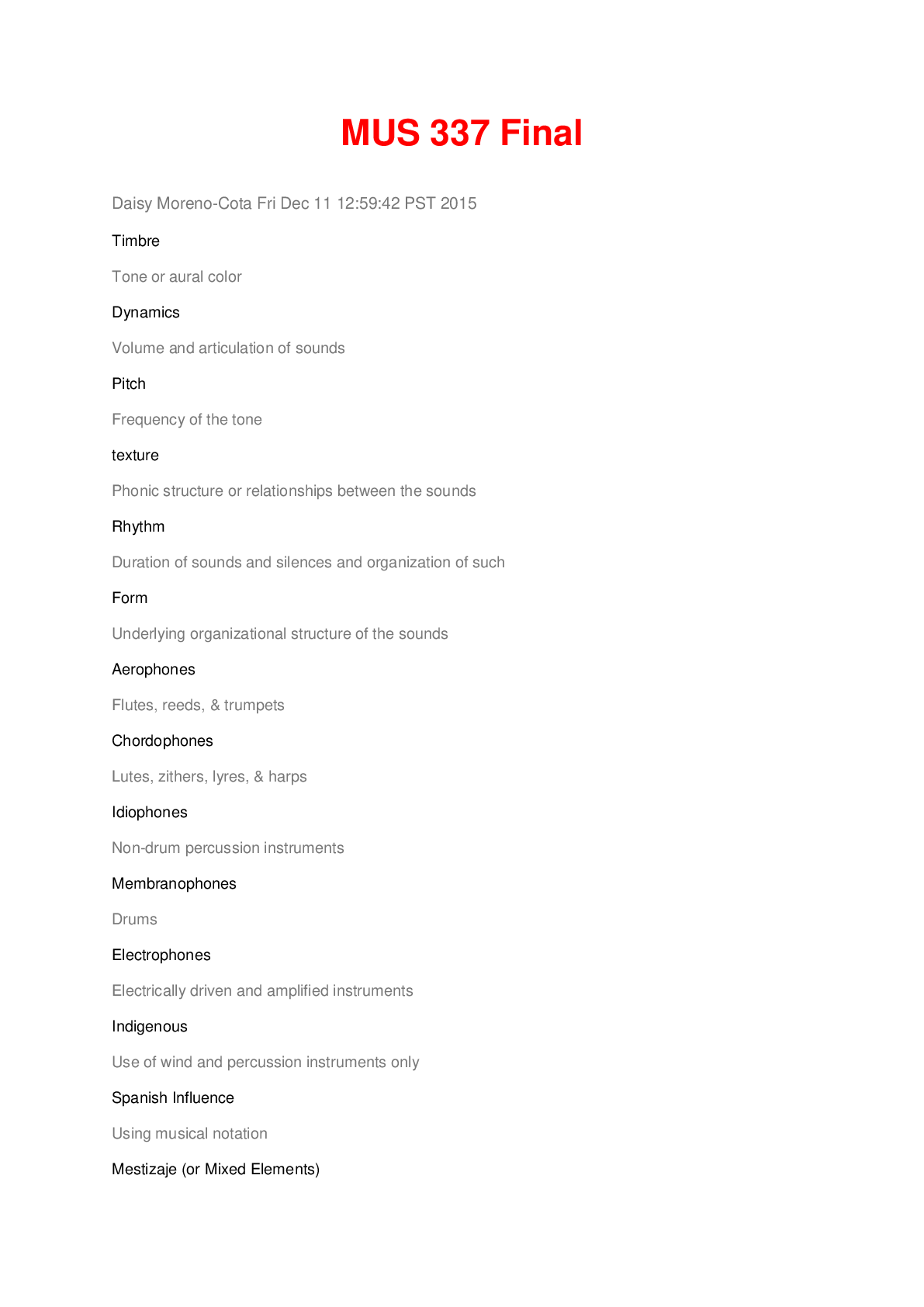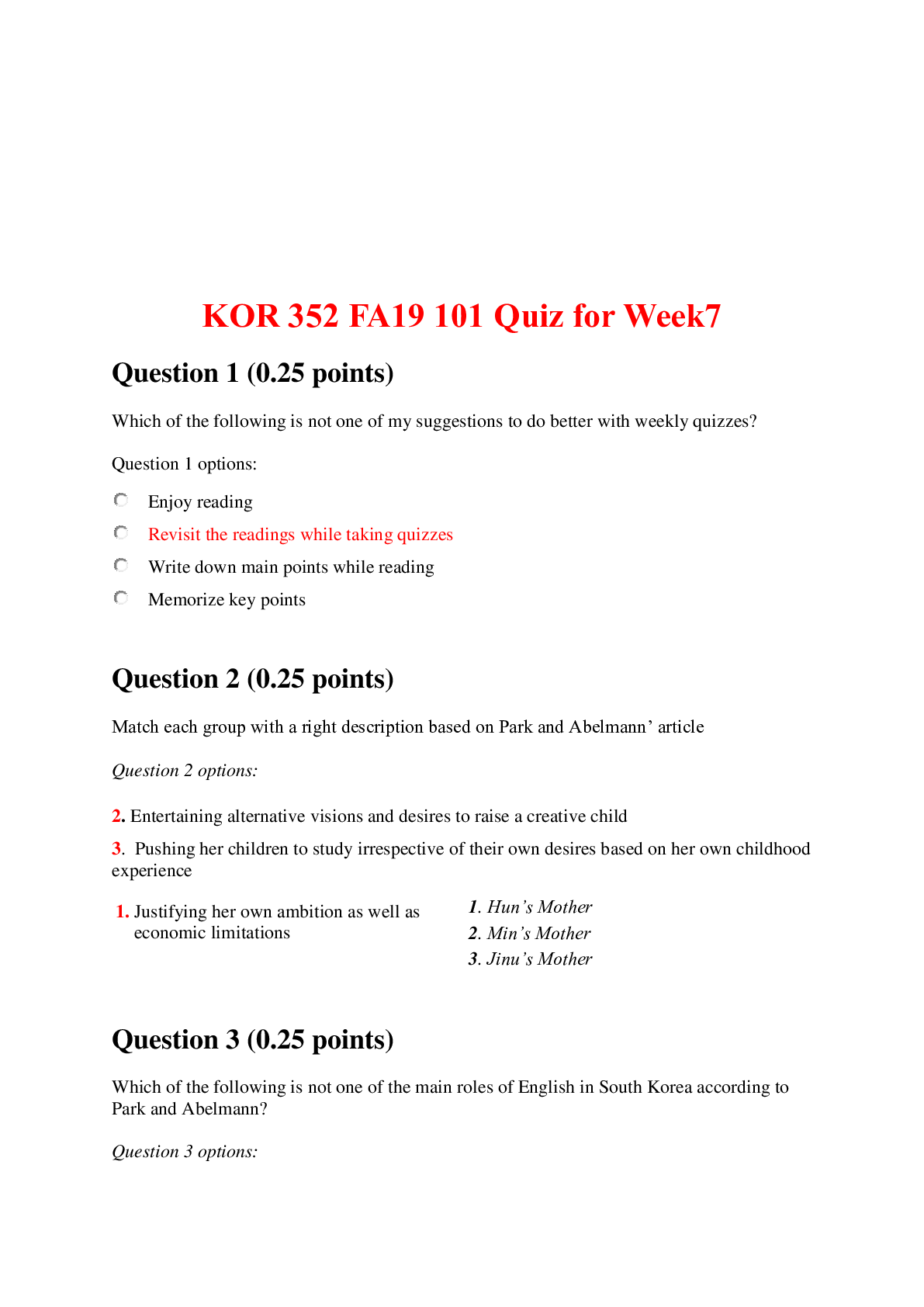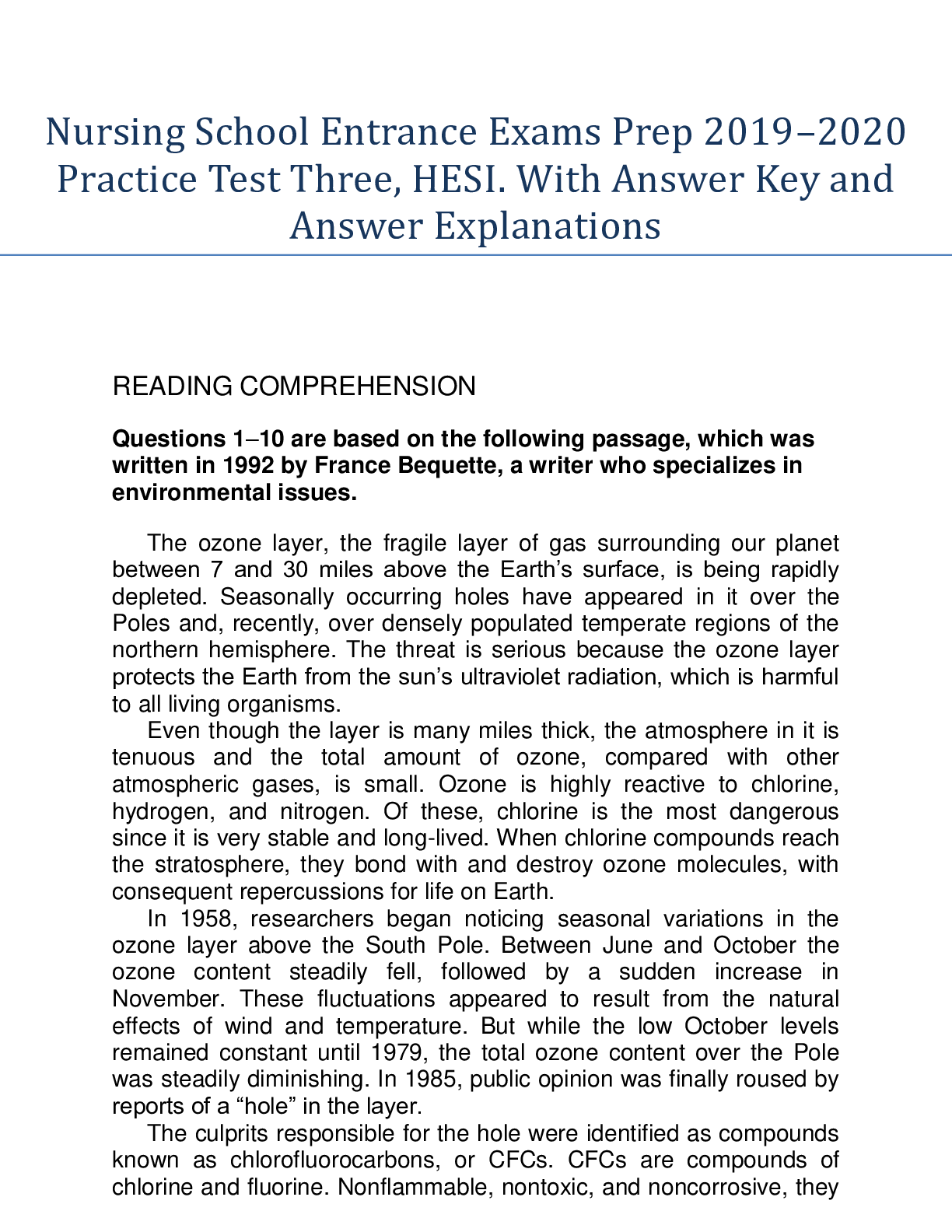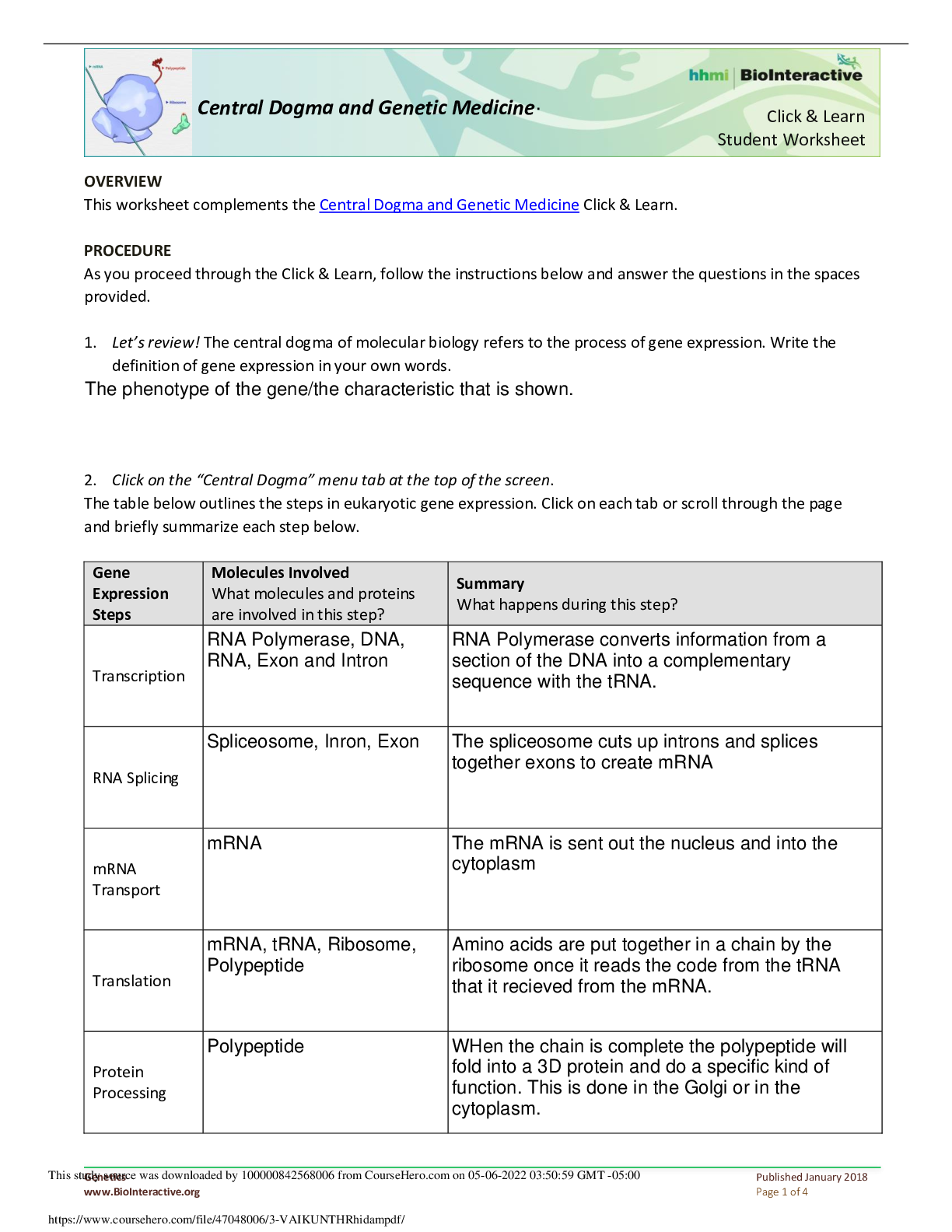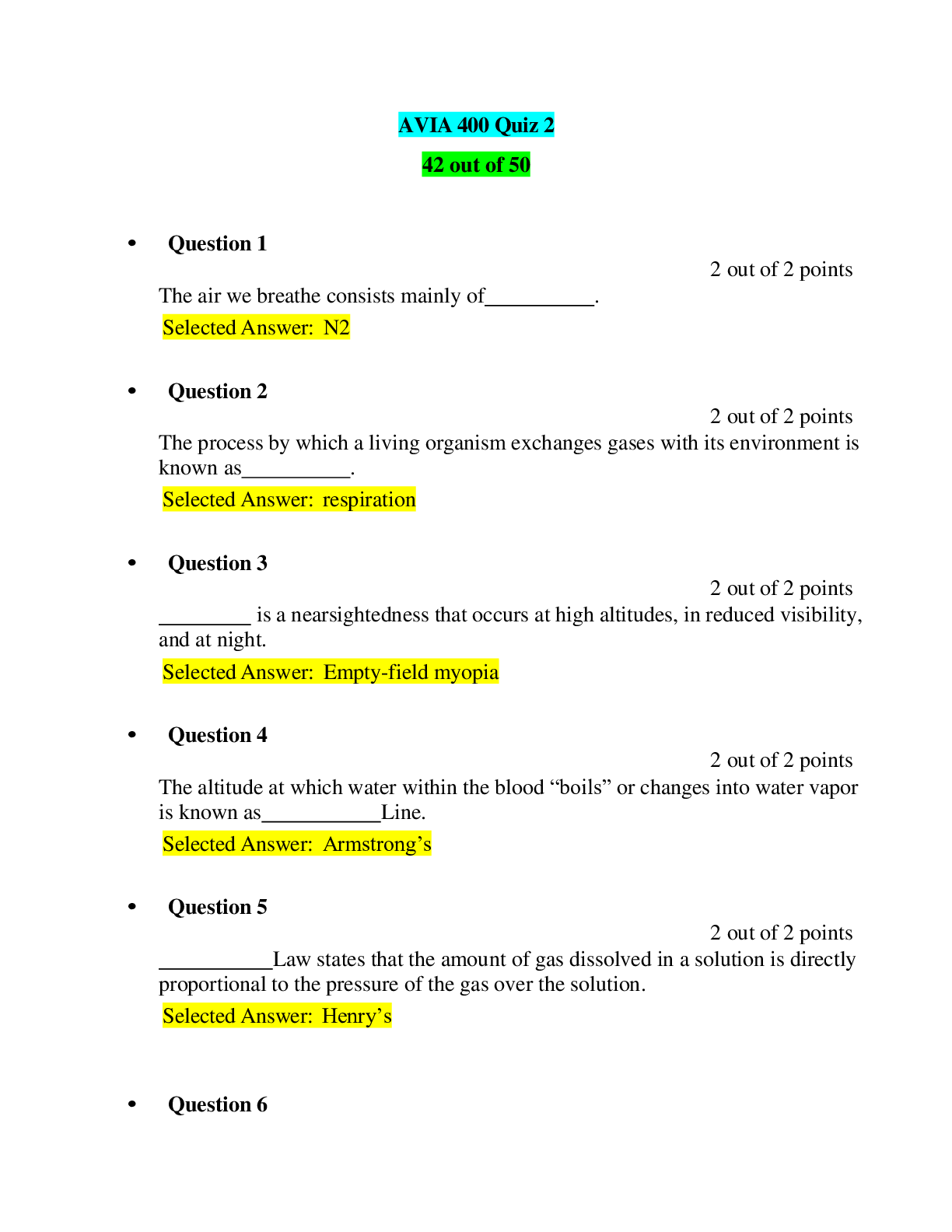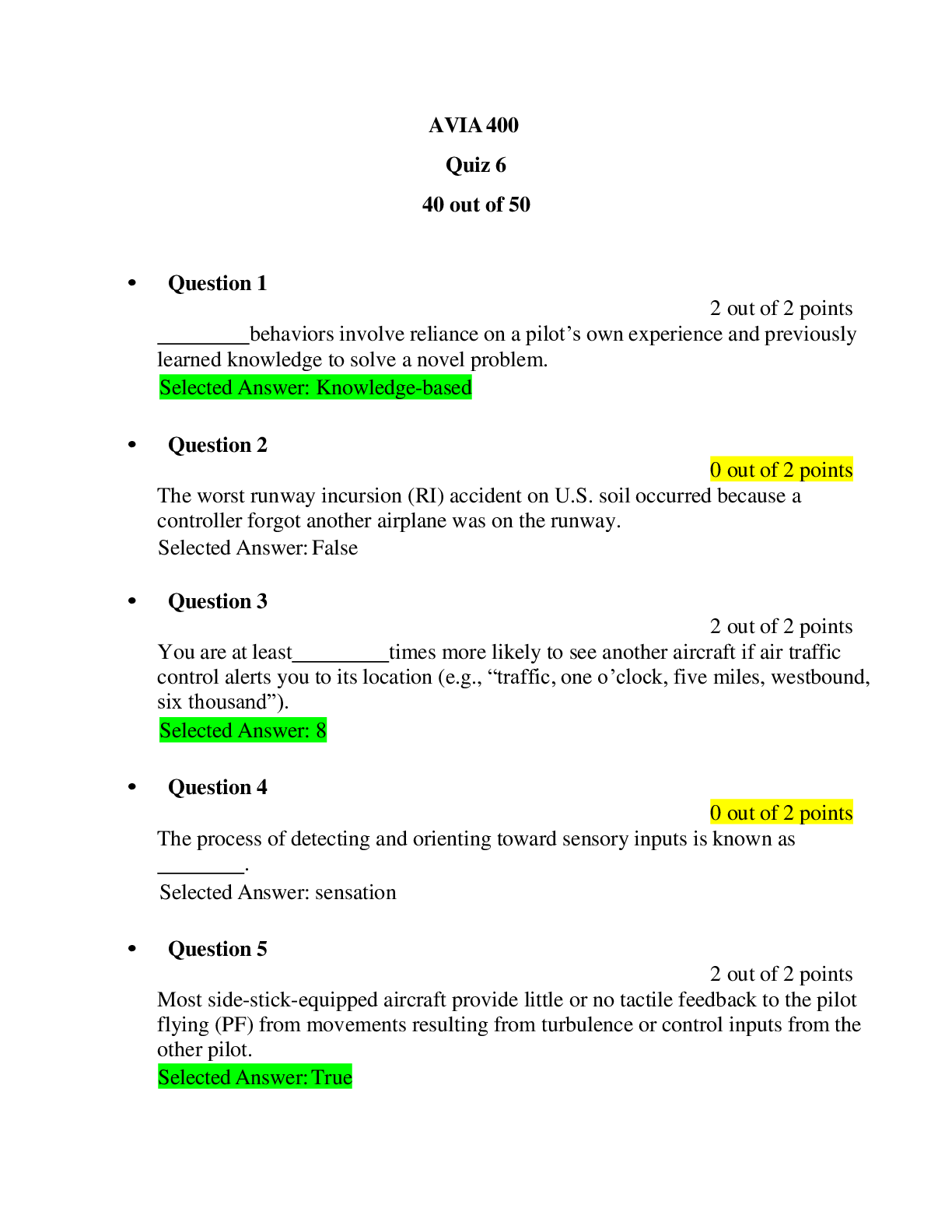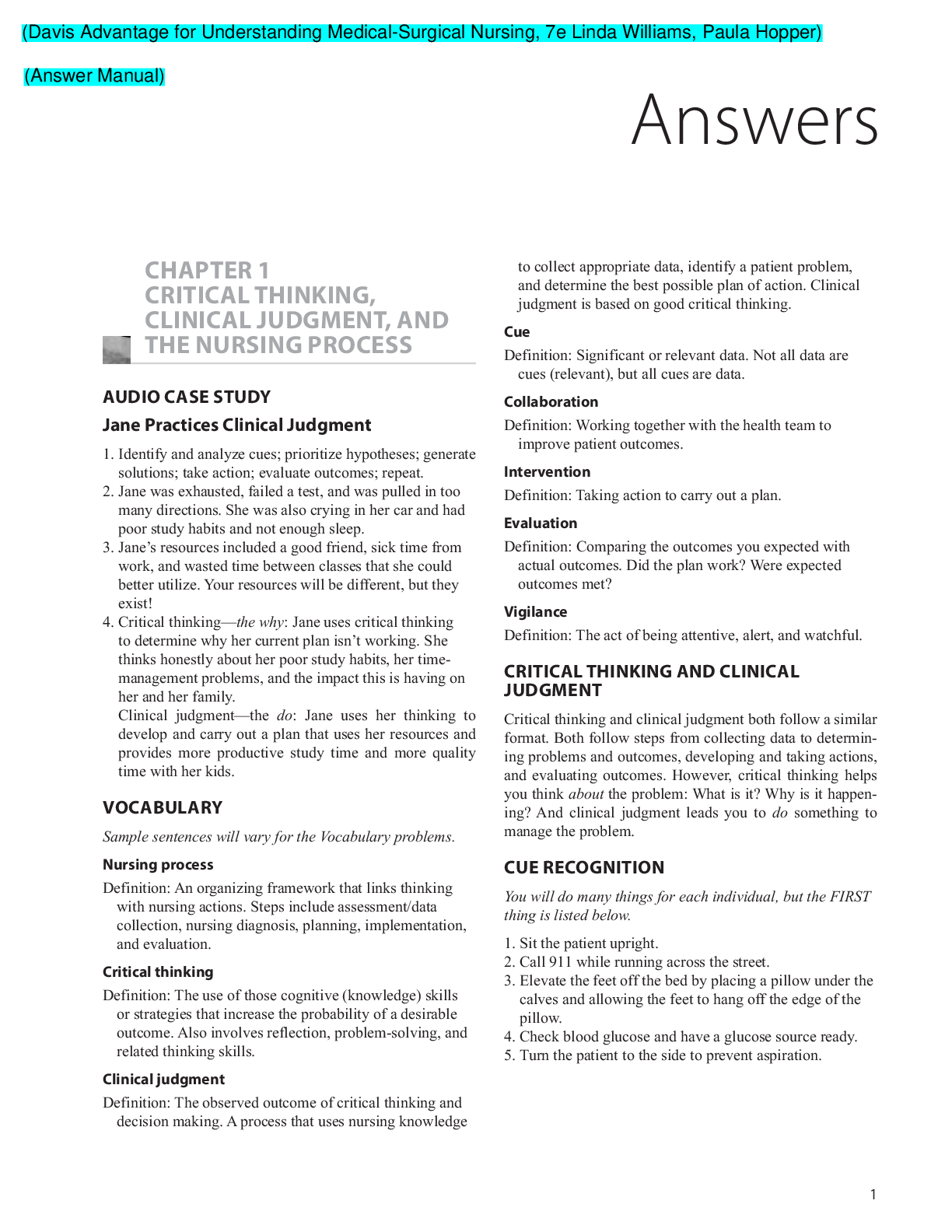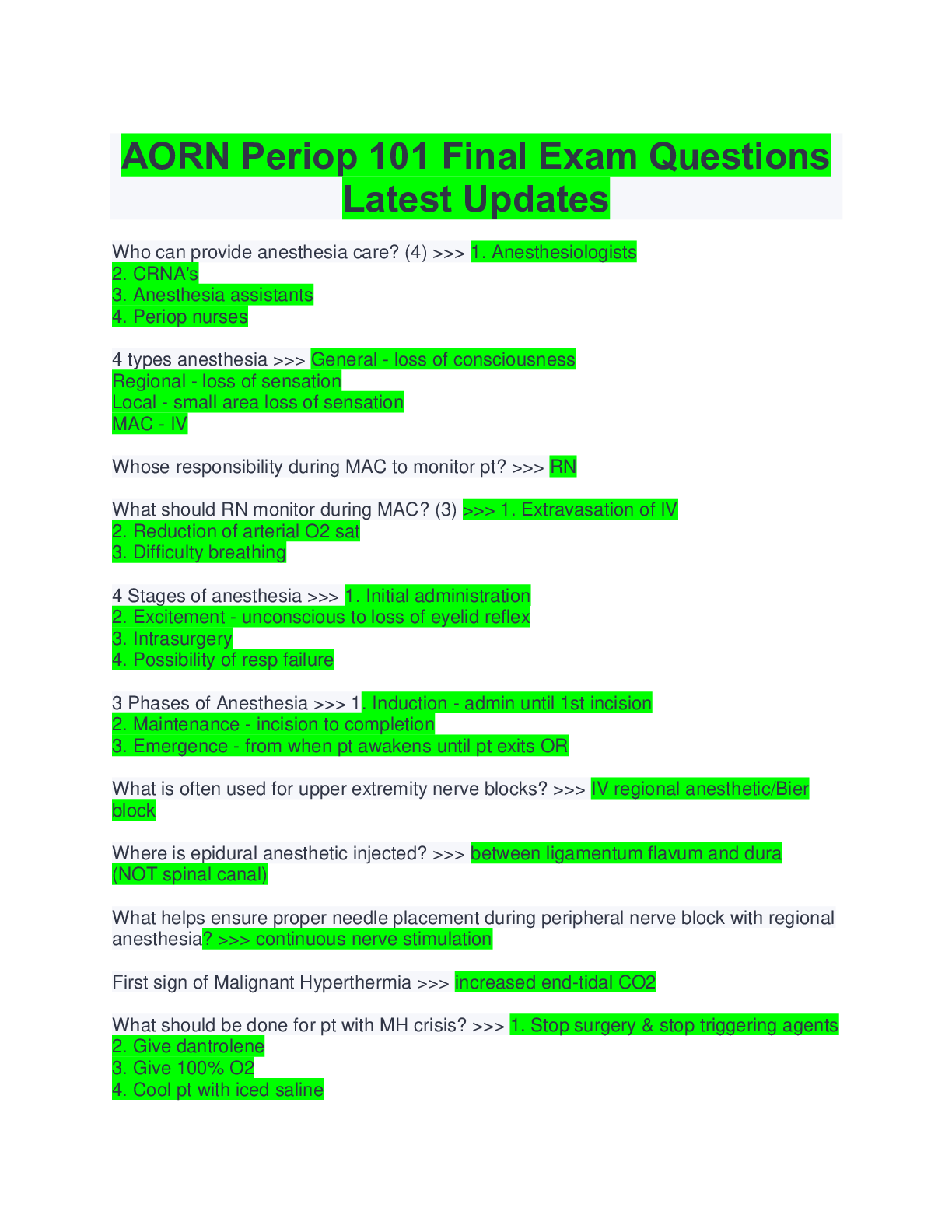Business > QUESTIONS & ANSWERS > Moraine Valley Community College -BUS 226 Final Test: Quiz Chapters 1 -8, Attempt 1. Scored A. (All)
Moraine Valley Community College -BUS 226 Final Test: Quiz Chapters 1 -8, Attempt 1. Scored A.
Document Content and Description Below
1.1. Which of the following is not a business level of ethics? 1.2. Which of the following is not an environmental dimension affecting organizations and jobs? 1.3. To which of the following does... ethics specifically refer? 1.4. _______ refers to “executives and firms that maintain good corporate image, proactive fair and equitable dealing with customers and employees, and earn profits by legitimate, legal means are de facto ethical.” 1.5. Which popular ethical myth is supported by Milton Freidman? 1.6. Which of the following is primary stakeholder? 1.7. Which of the following is not a popular myth about business ethics? 1.8. Which is the one most frequently observed types of misconduct? 1.9. Which of the following is a business ethics myth? 1.10. Which popular ethics myth asserts business is based on scientific principles? 1.11. Among top companies, this characteristic is generally of the most concern? 1.12. Politics, regulators, demographics, technology, law, and economics are the 6 environmental dimensions affecting organizations and jobs. 1.13. Deterioration of relationship is considered a cost to a company. 1.14. Special interest groups are secondary stakeholders in a company? 1.15. Descriptive ethics involves prescribing and evaluating your own personal ethics. 1.16. Ethics courses teach which of the following: 1.17. What percentage of employees at “the top ten best employers” think their coworkers display integrity and ethical conduct in the workplace? 1.18. Which of the following are business ethics levels? 1.19. Business ethics is primarily concerned with principles of right and wrong. 1.20. “Organizational level” is the primary, core level of analysis in the fields of Business Ethics 1.21. What percentage of companies in 2011 had weak ethical cultures? 1.22. Which of the following is not a business level of ethics? 1.23. Ethics is required in business because: 1.24. Normative ethics involves the examination of other people’s beliefs and principles 1.25. Business and ethics rarely mix together Quiz 2 2.1. ________ and__________ eliminate a person’s responsibility for causing harm and injury. 2.2. _________ holds that social responsibility is justified in terms of a moral duty toward helping less-advantage members of society through organized, tax-deductible charity and stewardship. 2.3. Which of the following should be considered when dealing wit utilitarianism? 2.4. Which of the justice principles compensates someone for past harm? 2.5. Which of the following is an example of moral “right”? 2.6. ___________ are concerned with the situation on hand. 2.7. Which of the following is a part of categorical imperative? 2.8. The __________ approach stipulates that all members of society should have access to certain benefits, and from whose enjoyment no one can be exactly excluded. 2.9. Which of the following are possible questions to ask when solving an ethical dilemma? 2.10. Which of the following is not a basis for ethical reasoning? 2.11. Which of the justice principles compensates someone for past harm? 2.12. A morally wrong act can usually be simply and specifically defined? 2.13. Progressivism and ethical idealism are two social responsibility models in the stakeholder model. 2.14. Utilitarianism argues doing the most good for the most parties in any given situation. 2.15. When addressing an ethical dilemma, the second step is to identify the problem? 2.16. A negative right: 2.17. Which of the justice principles has the criterion “Does the punishment fit the crime” 2.18. Believing that corporate behavior is motivated primarily by self-interest is a belief held by which of the following 2.19. To not isolate oneself with an action or decision is an example of which ethical test? 2.20. Which of the following are responsibility roles and models 2.21. Which stage of Kohlberg’s moral development is concerned with acting “right” to reach consensus by due process and agreement 2.22. If the action you are getting ready to take is agreed on by different impartial friends, based on their experience, it best describes which ethical test 2.23. Which of the following should be considered when dealing with utilitarianism 2.24. Utilitarianism argues doing the most good for the most parties in any given situation 2.25. Individualists are driven by natural reasoning, personal survival, and preservation 2.26. A person’s legal right and principle of duty have no connection to a moral right 2.27. Moral management employs which of the following technique 2.28. Stage 6 in Kohlberg’s moral development is universal ethical principles 2.29. Stage 4 in Kohlberg’s moral development is reward seeking 2.30. Which of the following is not a secondary stakeholder? 2.31. What are three general areas of ethics? 2.32. Which of the following topics related to ethics matter in business? 2.33. Mataethics considers where one’s ethical principles ”come from, and what they mean” 2.34. “Do unto others as you would have them do unto you” is an example of which ethical test? 2.35. If an action you are getting ready to take is agreed on by different impartial friends, based on their experience, is best described which ethical test? 2.36. Which stage of Kohlberg’s moral development is concerned with avoiding punishment? 2.37. Altruists are concerned primarily with other people’s welfare. 2.38. Logical presentation of facts is a basis for moral reasoning Quiz Chapter 3 3.1. Which of the following is nor a primary stakeholder? 3.2. A stakeholder’s power to exert control through strength in numbers in which power? 3.3. A stockholder approach will 3.4. An effective leader should ______ a supportive stakeholder. 3.5. Which of the following represents the second step in a general stakeholder analysis? 3.6. Which of the following crisis management recommendations to companies is not correct? 3.7. Which of the following issues management frameworks may be most helpful in tracking a controversial issue throughout its lifecycle? 3.8. The _______ stage in the Four Crisis Management Stages is return to normalcy? 3.9. Which of the following represents the last step in the Six-step Issues Management Process? 3.10. Which of the following represents the first step in the Six-Step Issues Management Process? 3.11. For classroom purposes, one recommendation to guide the inquiry is to assume which perspective when conducting a stakeholder analysis ____ . 3.12. Stakeholders are specifically named groups with specialized interests in a company. 3.13. Part of a stakeholder’s political power is their ability to influence the decision-making process of a company. 3.14. A stakeholder analysis only applies more to internal events a company is facing 3.15. The Six-Step Issues Management Process is a basic approach for proactively mapping, strategizing, and responding to issues that affect an organization. 3.16. The first step in the Seven-Phase Issue-Development Process is which of the following? 3.17. Using a stakeholder approach and analysis with an issues management approach is 3.18. Which of the following is a type of “power” a stakeholder could have? 3.19. Stakeholder management approach ideally uses ____ and ____ . 3.20. Part of a stakeholder’s political power is their ability to influence the decision-making process of a company. 3.21. Organizations are required by law to be morally responsible to their stakeholders 3.22. When dealing with a marginal stakeholder, the best strategy is to collaborate. 3.23. Critics of stakeholder theory hold that it 3.24. The second step in the Seven-Phase Issue-Development Process is which of the following? 3.25. Which of the following is not an aspect of the stakeholder management approach? 3.26. A stake is any interest, share, or claim, that a group or individual has in the outcome of a corporation’ 3.27. Acute stage in the Four Crisis Management Stages is: 3.28. A stakeholder that shows a high potential for threat and a low potential for cooperation is which of the following 3.29. The Seven-Step Issue-Development Process can take seven years to move from the first to the last phase Chapter 4 4.1. The “stick” or external regulations compliance consists of: 4.2. Which act of Congress gives the Justice Department investigative authority? 4.3. Which of the following designates air-quality standards? 4.4. Martha Stewart was convicted of what? 4.5. Which responsibilities does a company need to have to be socially responsible? 4.6. Which of the following in one of the worst companies according to the Top 10 Companies and Best Corporate Board Practices? 4.7. _____ was sentenced to 150 years in prison for running a Ponzi scheme. 4.8. Sarbanes-Oxley 4.9. Leib Pinter was charged with conspiracy to commit wire fraud due to which event(s)? D. 4.10. Which of the following is a purpose of the law and regulatory system governing businesses? 4.11. Which act prohibits price discrimination? 4.12. Conventional ethics focuses on the importance of relationships between business, customers, and stakeholders. 4.13. It is a company’s social responsibility to be fair and truthful in all transactions. 4.14. In a free-market society the market is always perfect. 4.15. The Sarbanes-Oxley Act was created to further regulate the financial and accounting practices of companies in response to major, market changing scandals. 4.16. Which of the following is a law that protect consumers? 4.17. Corporate philanthropy includes which of the following? 4.18. Which one of the following institutions was considered “Too Big To Fail”? 4.19. All of the following arguments are offered as problems with the free-market theory except: 4.20. According to Sarbanes-Oxley Act, CEOs are personally responsible for which of the following? 4.21. The Pure Food and Drug Act prohibits the adulteration and mislabeling of food and drugs in interstate commerce. 4.22. FSGO stands for Federal Sentencing Guidelines for Organizations 4.23. “Corporate Social Responsibility” involves an organization’s duty and obligation to respond to its stakeholders’ and stockholders’ economical, legal, ethical, and philanthropic concerns and issues. 4.24. A set of rules and assumptions about behavioral patterns among the various elements of society is which of the following? 4.25. The ______ was enacted to establish oversight, accountability, and enforce truthful and accurate financial reporting in public firms 4.26. Voluntary Self-Regulation consists of which of the following 4.27. Preventing Illegal activities can be best achieved by the following except: 4.28. The “rule of law” inhibit capitalism and democracies to thrive and complete globally 4.29. External Regulations Compliance is value-based 4.30. Controversial ethics focuses on the importance of relationships between business, customers, and stakeholders Chapter 5 5.1. A company that support a consumer’s free choice is fulfilling which of the following? 5.2. Research has shown that the most important part of labeling on a bottle of alcohol is 5.3. Which principle states that human life is biologically dependent on other forms of life? 5.4. Using environmentally-friendly business practices in the value chain to gain a competitive advantage is called 5.5. Punitive damages in product liability cases are 5.6. Youths continue to be target as primary customers by which industry 5.7. U.S. mobile and online ad spending is projected to be $6.1 billion by 5.8. _____ are considered the most important stakeholders 5.9. Paying compensation to a customer for harm due to a faulty product or for damage done by a business transaction is the right to 5.10. ____ is thought to cause more deaths that traffic accidents 5.11. To receive fair settlement to just claims, including compensation for misrepresentation, shoddy goods, or unsatisfactory services is considered 5.12. In 2007, direct marketing advertising is approximately $142 billion 5.13. According to research, punitive damages in product liability cases are rarely awarded, more rarely paid, and often reduced after the trial 5.14. The FTC and DOL are the federal agencies in the United States appointed and funded to menitor and eliminate false and misleading advertising when corporation self-regulation is not used or fails 5.15. The CPSC is not constrained by its enormous mission, limited resources, and critics who argue that the cost for maintaining the agency exceed the results and benefits produces by it 5.16. A company that supports a consumer’s free choice is fulfilling which of the following 5.17. Environmental pollution is due to all of the following except 5.18. “Big Brother” regulating what consumers can and should hear and see is what? 5.19. Being protected against product, production processes, and services which are hazardous to health or life is considered 5.20. _________ had the most cyber attacks with 2,402,722 5.21. Air pollution and greenhouse gases are not linked to global warming, as evidenced in the atmospheric oxygen levels which are 31 percent higher than preindustrial levels 5.22. Materialistic cultural views are a cause of environmental pollution 5.23. Which of the following arguments does not justify advertising 5.24. The Federal Trade Commission deems acts deceptive if they 5.25. _____ view environmental management as a priority item. 5.26. Product safety and liability is discussed in which doctrine 5.27. Which of the following is not a goal of government policy-makers toward consumers? 5.28. Airline safety is handled by the National Transportation Safety Board 5.29. A pragmatist considers environmental management an important business function Chapter 6 6.1. A signal that a company has a weak culture is 6.2. Ethical principles, intellectual property, and financial integrity and assurance should all be addressed in a company’s 6.3. Strong corporate culture includes 6.4. Traits that are exhibited at an individual level of a strong corporate culture include 6.5. Which of the following is a failure of ethical leadership? 6.6. All of the following companies use stakeholder relationship management theory except 6.7. Which of the following is not a value of the Levis Strauss & Co.? 6.8. A leader that learns from his/her shortcomings and uses all of his/her strengths is a(n) ____ type of leader 6.9. Which of the following is not a threat to worker autonomy? 6.10. In ethically strong companies, _______ percent of employees have observed misconduct in in the recent past 6.11. Which key concern/question is relevant to ask when inquiring about the structural dimensions of an organization from an ethical, values-based stakeholder perspective? 6.12. Since the 2008 subprime lending crisis and resulting Great Recession, critics have expressed concern about large corporation’ CEO pay not being aligned to performance 6.13. The stockholders of a company are technically responsible for disciplining and rewarding CEO 6.14. Strategic alignment requires an effective vision, mission, and values 6.15. “Manipulating leaders,” as described in the chapter, believe in strict ethical rules 6.16. _______ types of leaders believe and practice an end justify the means approach 6.17. A stakeholder, value-based leadership approach determines weather or not the organization and culture 6.18. Which of the following is influenced by an organization’s strategy? 6.19. To achieve strategic alignment one has to ask 6.20. To set direction and build relationships, what ethical leadership approach should be used 6.21. A stakeholder, value-based leadership approach determines weather or not the organization’s culture is integrated or fragmented 6.22. “Transforming leadership,” as described in the chapter, is also grounded in personal ethic 6.23. The following “spiritual” leadership (not religious) characteristic that are related to ethical leadership include the following except: 6.24. The _____ is the first step place to look to identify an organization’s values 6.25. The leadership of a company is the glue that holds together the other internal systems 6.26. Ethical blindness is when a leader does not perceive ethical issues due to inattention or inability 6.27. A third-party professional, so named, inside corporations to whom employees can take their grievances for review is called 6.28. Based on this chapter, all but one of the following indicate irresponsible and unethical leadership 6.29. “What is our strategic purpose for operating?” is answered by a company’s mission statement Chapter 7 7.1. This generation is also called the “baby busters” and generally feels overlooked. 7.2. A recent survey of women in the workplace found that 47% of women lacked which of the following 7.3. Denying someone a job because of their predisposition of contracting a disease is called what 7.4. Which minority group is now the largest in the Nation 7.5. Which of the following is not needed to ensure employees’ right to due process 7.6. Which of the following is not a step a manager can take to develop a privacy policy 7.7. When a senior executing is pair with a younger professional to catch up on new practices, this is called what 7.8. _____ extended punitive damages to victims of employment discrimination for the first time according to which of the following acts 7.9. ______ is based on the premise that employers should practice fairness and reasonableness in their actions with employees 7.10. Which issue continues to be a prominent civil rights platform 7.11. Sexual harassment includes 7.12. The right to privacy is an inherent workplace right 7.13. The GI generation served in WWII and went through the great depression 7.14. Every worker has the right to organize a union 7.15. Locker room and bathroom surveillance is a court-upheld privacy standard in the workplace 7.16. ____ is a pro of employers using video surveillance 7.17. Which of the following is not a right an employee has in the workplace 7.18. Which of the following are things an employee is not responsible to do for their employer 7.19. Which of the following is not recommended that managers take to develop corporate policy guidelines to prepare for private regulations 7.20. The _____ has lobbied against smoking in the workplace 7.21. Which generation is currently the most powerful demographic with about 77 million members 7.22. Reverse discrimination was a problem faced by which university 7.23. In 2010, 75% of workers claim to be involved in a workplace romance 7.24. Sexual harassment is illegal under Title XI of the 1964 Civil Right Act 7.25. Which of the following is not a court upheld technology privacy violation 7.26. The generation was too young to fight in WWII. They are very patriotic and self-sacrifices 7.27. An employer must have “just cause” to terminate an employee 7.28. Whistleblowers are always protected by law, under any circumstance 7.29. It is not recommended that a person consider his or her motives when deciding whether to blow the whistle on an employer Chapter 8 8.1. MNE’s are also called 8.2. MNE’s should 8.3. What author developed a four-stage process for negotiation 8.4. Which of the following tactics should not be used for solving ethical dilemmas internationally, according to DeGeorge 8.5. When a company abstracts all local and regional differences and norms, coming up with a more cosmopolitan set of standards and solutions for its actions in the host country, this is called what? 8.6. Guy’s then core values include which of the following 8.7. MNEs benefit their host countries in all of the following ways except 8.8. When a company applies the values and norms of its local host we call this a 8.9. In a(n) _____ style, a company applies its own domestic values and rules 8.10. According to Josef Badaracco, company executives should ask themselves ____ when considering ethical principles-in-action? 8.11. This act prohibits the bribing of foreign public official by US companies 8.12. Venezuela is ranked the most corrupt nation in the world 8.13. Triple bottom line has 3 dimensions including the economic, environmental, and social dimensions 8.14. American negotiators are known for their integrity 8.15. The Ford-Bridgestone/Firestone crisis was a domestic crisis 8.16. Which of the following is not a criticism of MNEs 8.17. _____ are corporations that own and control production facilities outside of their country of origin 8.18. _____ negotiators tend to be the most persistent and determined 8.19. Leaders are responsible for doing what with ethical standards 8.20. When entering a new country, MNE’s tend to 8.21. Many international agencies have developed global values to combat unethical behavior 8.22. An interconnection style applies shared norms with other companies and groups 8.23. Free trade is an agreement between nations with open borders 8.24. Counterfeit and pirated products account for ____ percent of the global economy 8.25. The underlying sources of the guidelines for MNE’s include beliefs in 8.26. Which characteristic of employees serves as the best predictor of beliefs and attitudes 8.27. Japanese negotiators tend to be not very dedicated to their job 8.28. “The belief in the inherent superiority of one’s own ethic group of culture” is called 8.29. [Show More]
Last updated: 1 year ago
Preview 1 out of 19 pages
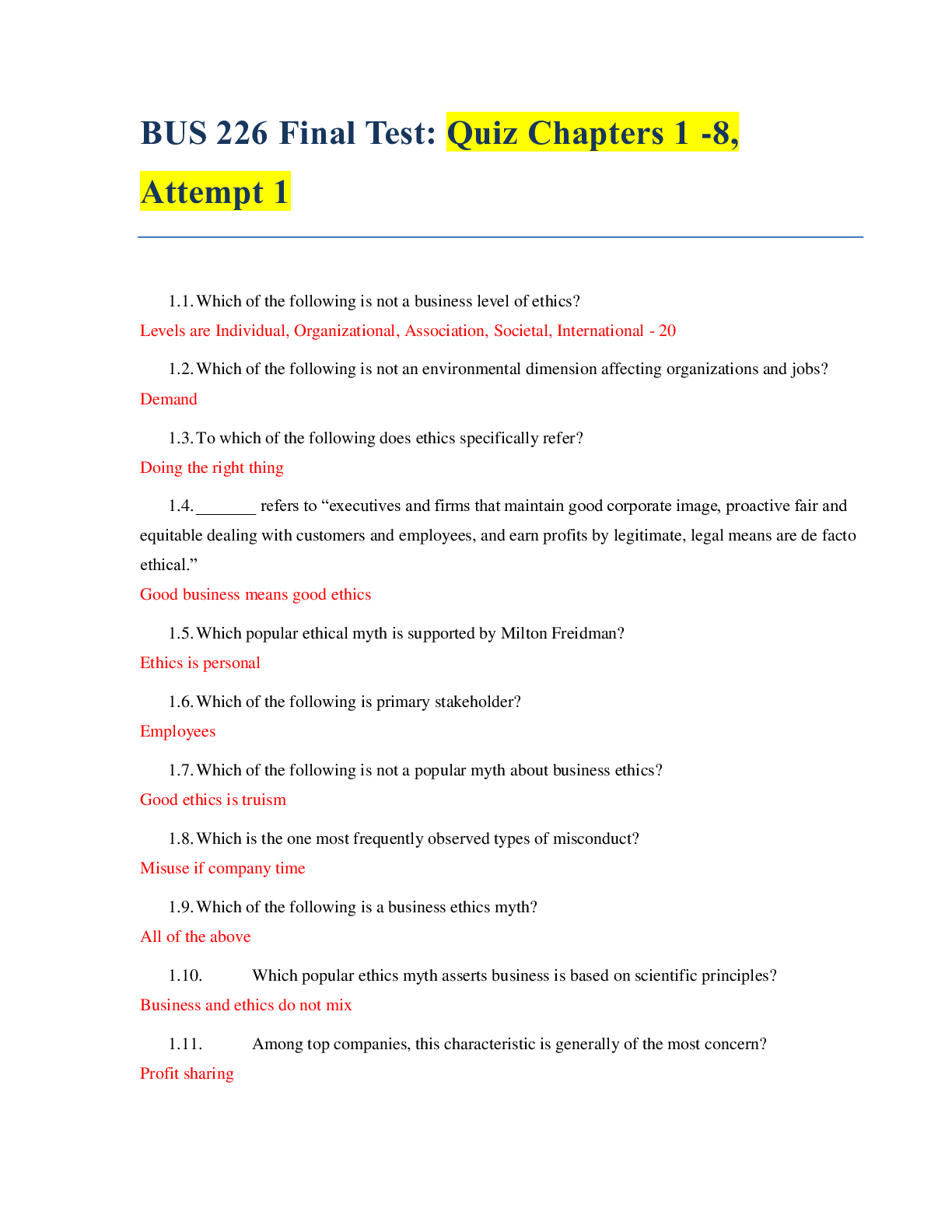
Reviews( 0 )
Document information
Connected school, study & course
About the document
Uploaded On
May 15, 2020
Number of pages
19
Written in
Additional information
This document has been written for:
Uploaded
May 15, 2020
Downloads
0
Views
46







